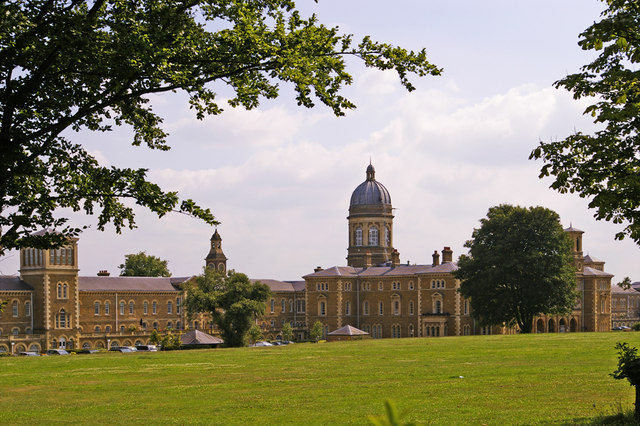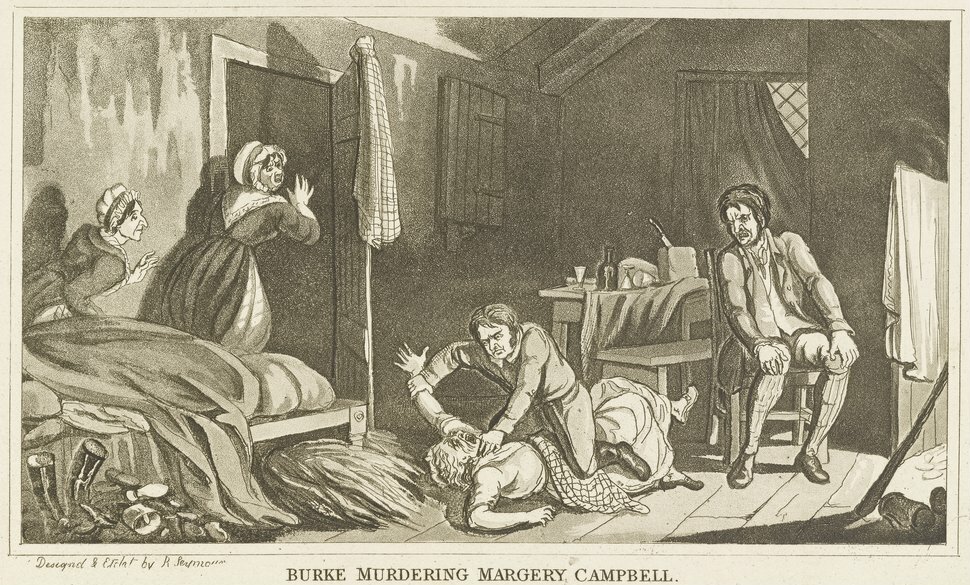|
Aaron Kosminski
Aaron Kosminski (born Aron Mordke Kozmiński; 11 September 1865 – 24 March 1919) was a Polish barber and hairdresser, and suspect in the Jack the Ripper case. Kosminski was a Polish Jew who emigrated from Congress Poland to England in the 1880s. He worked as a hairdresser in Whitechapel in the East End of London, where Whitechapel murders, a series of murders ascribed to an unidentified figure nicknamed "Jack the Ripper" were committed in 1888. From 1891, Kosminski was institutionalised after he threatened his sister with a knife. He was first held at Colney Hatch Lunatic Asylum, and then transferred to the Leavesden Hospital, Leavesden Asylum. Police officials from the time of the murders named one of their suspects as "Kosminski" (the forename was not given), and described him as a Polish Jew in an insane asylum. Almost a century after the final murder, the suspect "Kosminski" was identified as Aaron Kosminski; but there was little evidence to connect him with the "Kosminsk ... [...More Info...] [...Related Items...] OR: [Wikipedia] [Google] [Baidu] |
Kłodawa
Kłodawa is a town in central Poland with 6,699 inhabitants (2014). It is situated in the Greater Poland Voivodeship (since 1999), having previously been in Konin Voivodeship (1975–1998). Kłodawa lies on the Rgilewka (a tributary of the Warta River). The town contains the Kłodawa Salt Mine, the largest operating salt mine in Poland, extracting halite and salts of potassium and magnesium. Kłodawa was settled in the 11th century by craftsmen building the Church of St. Giles. It gained municipal rights in 1430. Much of the town was destroyed in the wars of the 17th century and World War II. It was once home to a vibrant Jewish community wiped out during the Holocaust, German occupation. On the outskirts there is a cemetery from the ancient Lusatian culture. History Four-thousand-year-old traces of settlements in the area of Kłodawa can be found in the nearby village of Słupeczka. Remains of the Lusatian culture, about 2500 years old, can be found in Old Kłodawa. In the ... [...More Info...] [...Related Items...] OR: [Wikipedia] [Google] [Baidu] |
Pogrom
A pogrom () is a violent riot incited with the aim of massacring or expelling an ethnic or religious group, particularly Jews. The term entered the English language from Russian to describe 19th- and 20th-century attacks on Jews in the Russian Empire (mostly within the Pale of Settlement). Similar attacks against Jews which also occurred at other times and places retrospectively became known as pogroms. Sometimes the word is used to describe publicly sanctioned purgative attacks against non-Jewish groups. The characteristics of a pogrom vary widely, depending on the specific incident, at times leading to, or culminating in, massacres. Significant pogroms in the Russian Empire included the Odessa pogroms, Warsaw pogrom (1881), Kishinev pogrom (1903), Kiev pogrom (1905), and Białystok pogrom (1906). After the collapse of the Russian Empire in 1917, several pogroms occurred amidst the power struggles in Eastern Europe, including the Lwów pogrom (1918) and Kiev Pogroms (1 ... [...More Info...] [...Related Items...] OR: [Wikipedia] [Google] [Baidu] |
Dan Farson
Daniel James Negley Farson (8 January 1927 – 27 November 1997) was a British writer and broadcaster, strongly identified with the early days of commercial television in the UK, when his sharp, investigative style contrasted with the BBC's more deferential culture. Farson was a prolific biographer and autobiographer, chronicling the bohemian life of Soho and his own experiences of running a music-hall pub on east London's Isle of Dogs. His memoirs were titled ''Never a Normal Man''. Early life Farson was born in Kensington, west London, the son of an American journalist, Negley Farson, and his British wife. His childhood was mostly divided between Britain and North America. He visited Germany with his father while Negley was reporting on the Nazi regime, and was patted on the head by Adolf Hitler, who described him as a "good Aryan boy". Farson briefly attended the British public school Wellington College, whose militaristic regime was not to his taste. He had already become i ... [...More Info...] [...Related Items...] OR: [Wikipedia] [Google] [Baidu] |
Henry McLaren, 2nd Baron Aberconway
Henry Duncan McLaren, 2nd Baron Aberconway, (16 April 1879 – 23 May 1953) was a British politician, horticulturalist and industrialist. He was the son of Charles McLaren, 1st Baron Aberconway and Laura Pochin. Education Born in Richmond upon Thames, he was educated at Eton and obtained a Master of Arts from Balliol College, Oxford. In 1903 he became a barrister of Lincoln's Inn. Career In 1906 he was elected Member of Parliament (MP) for West Staffordshire as a Liberal, and was Private Under-Secretary to the President of the Board of Trade, David Lloyd George, until 1908. In 1910, he stood for his father's old seat of Bosworth and replaced him. He left politics in 1922, and succeeded his father to the Barony in 1934. McLaren was an industrialist, and chaired companies from both sides of the family, including John Brown & Company and the Tredegar Iron and Coal Company. In 1915 he was the founding chairman of the Design and Industries Association. Around the end of ... [...More Info...] [...Related Items...] OR: [Wikipedia] [Google] [Baidu] |
Metropolitan Police
The Metropolitan Police Service (MPS), formerly and still commonly known as the Metropolitan Police (and informally as the Met Police, the Met, Scotland Yard, or the Yard), is the territorial police force responsible for law enforcement and the prevention of crime in Greater London. In addition, the Metropolitan Police is also responsible for some specialised matters throughout the United Kingdom; these responsibilities include co-ordinating and leading national counter-terrorism measures and the personal safety of specific individuals, such as the Monarch and other members of the Royal Family, members of the Government, and other officials (such as the Leader of the Opposition). The main geographical area of responsibilities of the Metropolitan Police District consists of the 32 London boroughs, but does not include the City of London proper — that is, the central financial district also known as the "Square Mile" — which is policed by a separate force, the City of ... [...More Info...] [...Related Items...] OR: [Wikipedia] [Google] [Baidu] |
Melville Macnaghten
Sir Melville Leslie Macnaghten (16 June 1853, Woodford, London −12 May 1921) was Assistant Commissioner (Crime) of the London Metropolitan Police from 1903 to 1913. A highly regarded and famously affable figure of the late Victorian and Edwardian eras he played major investigative roles in cases that led to the establishment and acceptance of fingerprint identification. He was also a major player in the pursuit and capture of Dr. Crippen, and of the exoneration of a wrongly convicted man, Adolph Beck, which helped lead to the creation of the Court of Criminal Appeal in 1907. When he prematurely retired in 1913 due to illness, Macnaghten claimed to journalists that he knew the exact identity of Jack the Ripper, the nickname of the unknown serial killer of poor prostitutes in London's impoverished East End during the late Victorian era. The police chief called the killer "that remarkable man", but refused to name him or divulge details that might identify him, except to reveal ... [...More Info...] [...Related Items...] OR: [Wikipedia] [Google] [Baidu] |
Serial Killer
A serial killer is typically a person who murders three or more persons,A * * * * with the murders taking place over more than a month and including a significant period of time between them. While most authorities set a threshold of three murders, others extend it to four or lessen it to two. Psychological gratification is the usual motive for serial killing, and many serial murders involve sexual contact with the victim. The Federal Bureau of Investigation (FBI) states that the motives of serial killers can include anger, thrill-seeking, financial gain, and attention seeking, and killings may be executed as such. The victims may have something in common; for example, demographic profile, appearance, gender or race. Often the FBI will focus on a particular pattern serial killers follow. Based on this pattern, this will give key clues into finding the killer along with their motives. Although a serial killer is a distinct classification that differs from that of a mass mu ... [...More Info...] [...Related Items...] OR: [Wikipedia] [Google] [Baidu] |
Macnaghten Memorandum
Macnaghten may refer to: * Clan Macnaghten *Daniel M'Naghten, namesake of the M'Naghten rules *Edward Macnaghten *Elliot Macnaghten *Half Hung MacNaghten * Macnaghten Baronets *Melville Macnaghten *William Hay Macnaghten (1793-1841), killed in the First Anglo-Afghan War See also * Macnaughtan Macnaughtan is a Scottish surname. Notable people with the surname include: *Alan MacNaughtan (1920–2002), Scottish actor *Andrew MacNaughtan Andrew Neil MacNaughtan (25 February 196425 January 2012) was a Canadian photographer and music vid ... * McNaughton {{Disambiguation, surname ... [...More Info...] [...Related Items...] OR: [Wikipedia] [Google] [Baidu] |
Workhouse
In Britain, a workhouse () was an institution where those unable to support themselves financially were offered accommodation and employment. (In Scotland, they were usually known as poorhouses.) The earliest known use of the term ''workhouse'' is from 1631, in an account by the mayor of Abingdon reporting that "we have erected wthn our borough a workhouse to set poorer people to work". The origins of the workhouse can be traced to the Statute of Cambridge 1388, which attempted to address the labour shortages following the Black Death in England by restricting the movement of labourers, and ultimately led to the state becoming responsible for the support of the poor. However, mass unemployment following the end of the Napoleonic Wars in 1815, the introduction of new technology to replace agricultural workers in particular, and a series of bad harvests, meant that by the early 1830s the established system of poor relief was proving to be unsustainable. The New Poor Law of 1834 ... [...More Info...] [...Related Items...] OR: [Wikipedia] [Google] [Baidu] |
Mile End
Mile End is a district of the London Borough of Tower Hamlets in the East End of London, England, east-northeast of Charing Cross. Situated on the London-to-Colchester road, it was one of the earliest suburbs of London. It became part of the metropolitan area in 1855, and is connected to the London Underground. It was also known as Mile End Old Town; the name provides a geographical distinction from the unconnected former hamlet called Mile End New Town. In 2011, Mile End had a population of 28,544. (Mile End also identifies a district of Montreal, north of the Mount Royal park, a largely English-speaking enclave in this bilingual Canadian city.) History Toponymy Mile End is recorded in 1288 as ''La Mile ende''. It is formed from the Middle English 'mile' and 'ende' and means 'the hamlet a mile away'. The mile distance was in relation to Aldgate in the City of London, reached by the London-to-Colchester road. In around 1691 Mile End became known as Mile End Old Town, because ... [...More Info...] [...Related Items...] OR: [Wikipedia] [Google] [Baidu] |








